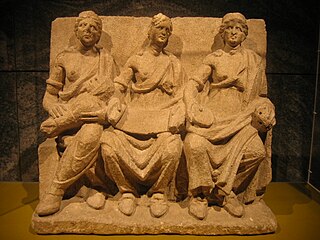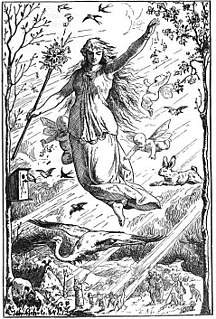
Týr is a god in Germanic mythology, a valorous and powerful member of the Æsir and patron of warriors and mythological heroes. In Norse mythology, which provides most of the surviving narratives about gods among the Germanic peoples, Týr sacrifices his hand to the monstrous wolf Fenrir, who bites it off when he realizes the gods have bound him. Týr is foretold of being consumed by the similarly monstrous dog Garmr during the events of Ragnarök.

Yggdrasil, in Norse cosmology, is an immense and central sacred tree. Around it exists all else, including the Nine Worlds.

In Norse mythology, Eir is a goddess or valkyrie associated with medical skill. Eir is attested in the Poetic Edda, compiled in the 13th century from earlier traditional sources; the Prose Edda, written in the 13th century by Snorri Sturluson; and in skaldic poetry, including a runic inscription from Bergen, Norway from around 1300. Scholars have theorized about whether these three sources refer to the same figure, and debate whether Eir may have been originally a healing goddess or a valkyrie. In addition, Eir has been theorized as a form of the goddess Frigg and has been compared to the Greek goddess Hygieia.
In Norse mythology, Vör is a goddess associated with wisdom. Vör is attested in the Prose Edda, written in the 13th century by Snorri Sturluson; and twice in kennings employed in skaldic poetry. Scholars have proposed theories about the implications of the goddess.

In Norse mythology, a valkyrie is one of a host of female figures who choose those who may die in battle and those who may live. Selecting among half of those who die in battle go to Fólkvangr, Freyjas afterlife, the other half go to the god Odin's hall called Valhalla. There, the deceased warriors become einherjar. When the einherjar are not preparing for the events of Ragnarök, the valkyries bear them mead. Valkyries also appear as lovers of heroes and other mortals, where they are sometimes described as the daughters of royalty, sometimes accompanied by ravens and sometimes connected to swans or horses.
In Norse mythology, Vár or Vór is a goddess associated with oaths and agreements. Vár is attested in the Poetic Edda, compiled in the 13th century from earlier traditional sources; the Prose Edda, written in the 13th century by Snorri Sturluson; and kennings found in skaldic poetry and a runic inscription. Scholars have proposed theories about the implications of the goddess.

The Matres and Matronae were female deities venerated in Northwestern Europe, of whom relics are found dating from the first to the fifth century AD. They are depicted on votive offerings and altars that bear images of goddesses, depicted almost entirely in groups of three, that feature inscriptions and were venerated in regions of Germania, Eastern Gaul, and Northern Italy that were occupied by the Roman army from the first to the fifth century.

In Norse mythology, the Nine Mothers of Heimdallr are nine sisters who gave birth to the god Heimdallr. The Nine Mothers of Heimdallr are attested in the Prose Edda, written in the 13th century by Snorri Sturluson; in the poetry of skalds; and possibly also in a poem in the Poetic Edda, a book of poetry compiled in the 13th century from earlier traditional material. Scholars have debated what being "born of nine mothers" implies and have sought to connect the notion to other European folk motifs. Scholars have theorized that Heimdallr's Nine Mothers may be identical to the Nine Daughters of Ægir and Rán, who personify waves. In turn, Heimdallr would be born of the sea.
In Norse mythology, Hoddmímis holt is a location where Líf and Lífþrasir are foretold to survive the long winters of Fimbulvetr. Hoddmímis holt is attested in the Poetic Edda, compiled in the 13th century from earlier traditional sources, and the Prose Edda, written in the 13th century by Snorri Sturluson. Like the very similarly named Mímameiðr, scholars generally consider Hoddmímis holt to be another name for Yggdrasil and connect it to folklore recorded from continental Germanic folklore.
In Norse mythology, Syn is a goddess associated with defensive refusal. Syn is attested in the Prose Edda, written in the 13th century by Snorri Sturluson; and in kennings employed in skaldic poetry. Scholars have proposed theories about the implications of the goddess.

Ēostre is a West Germanic spring goddess. By way of the Germanic month bearing her name, she is the namesake of the festival of Easter in some languages. Ēostre is attested solely by Bede in his 8th-century work The Reckoning of Time, where Bede states that during Ēosturmōnaþ, pagan Anglo-Saxons had held feasts in Ēostre's honour, but that this tradition had died out by his time, replaced by the Christian Paschal month, a celebration of the resurrection of Jesus.

Norse cosmology is the study of the cosmos (cosmology) as perceived by the North Germanic peoples. The topic encompasses concepts from Norse mythology, such as notions of time and space, cosmogony, personifications, anthropogeny, and eschatology. Like other aspects of Norse mythology, these concepts are primarily recorded in the Poetic Edda, a collection of poems compiled in the 13th century, and the Prose Edda, authored by Icelander Snorri Sturluson in the 13th century, who drew from earlier traditional sources. Together these sources depict an image of Nine Worlds around a cosmic tree, Yggdrasil.
The Harii were, according to 1st century CE Roman historian Tacitus, a Germanic people. In his work Germania, Tacitus describes them as using black shields and painting their bodies, and attacking at night as a shadowy army, much to the terror of their opponents. Theories have been proposed connecting the Harii to the einherjar, ghostly warriors in service to the god Odin, attested much later among the North Germanic peoples by way of Norse mythology, and to the tradition of the Wild Hunt, a procession of the dead through the winter night sky sometimes led by Odin.
In Norse mythology, Kára is a valkyrie, attested in the prose epilogue of the Poetic Edda poem Helgakviða Hundingsbana II.
In Germanic paganism, Tamfana is a goddess. The destruction of a temple dedicated to the goddess is recorded by Roman senator Tacitus to have occurred during a massacre of the Germanic Marsi by forces led by Roman general Germanicus. Scholars have analyzed the name of the goddess and have advanced theories regarding her role in Germanic paganism.
Mōdraniht or Modranicht was an event held at what is now Christmas Eve by the Anglo-Saxon pagans. The event is attested by the medieval English historian Bede in his eighth-century Latin work De temporum ratione. It has been suggested that sacrifices may have occurred during this event. Scholars have proposed connections between the Anglo-Saxon Mōdraniht and events attested among other Germanic peoples, and the Germanic Matres and Matronae, female beings attested by way of altar and votive inscriptions, nearly always appearing in trios.
In Germanic paganism, Baduhenna is a goddess. Baduhenna is solely attested in Tacitus's Annals where Tacitus records that a sacred grove in ancient Frisia was dedicated to her, and that near this grove 900 Roman soldiers were killed in 28 CE. Scholars have analyzed the name of the goddess and linked the figure to the Germanic Matres and Matronae.
In Norse mythology and later Icelandic folklore, landdísir are beings who live in landdísasteinar, specific stones located in Northwestern Iceland which were treated with reverence into the 18th and 19th centuries. The landdísir are not recorded in Old Norse sources, but belief in them is assumed from the name landdísasteinar.








